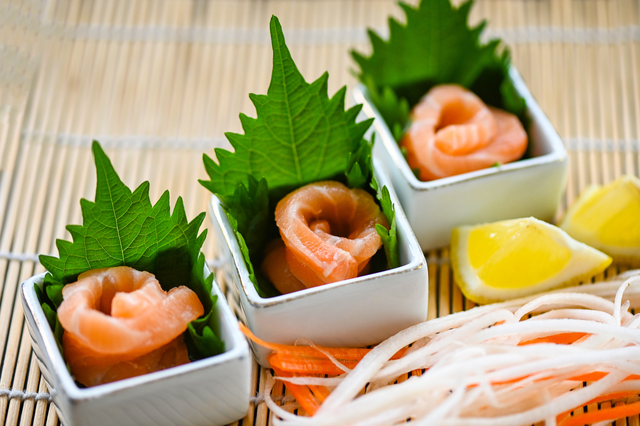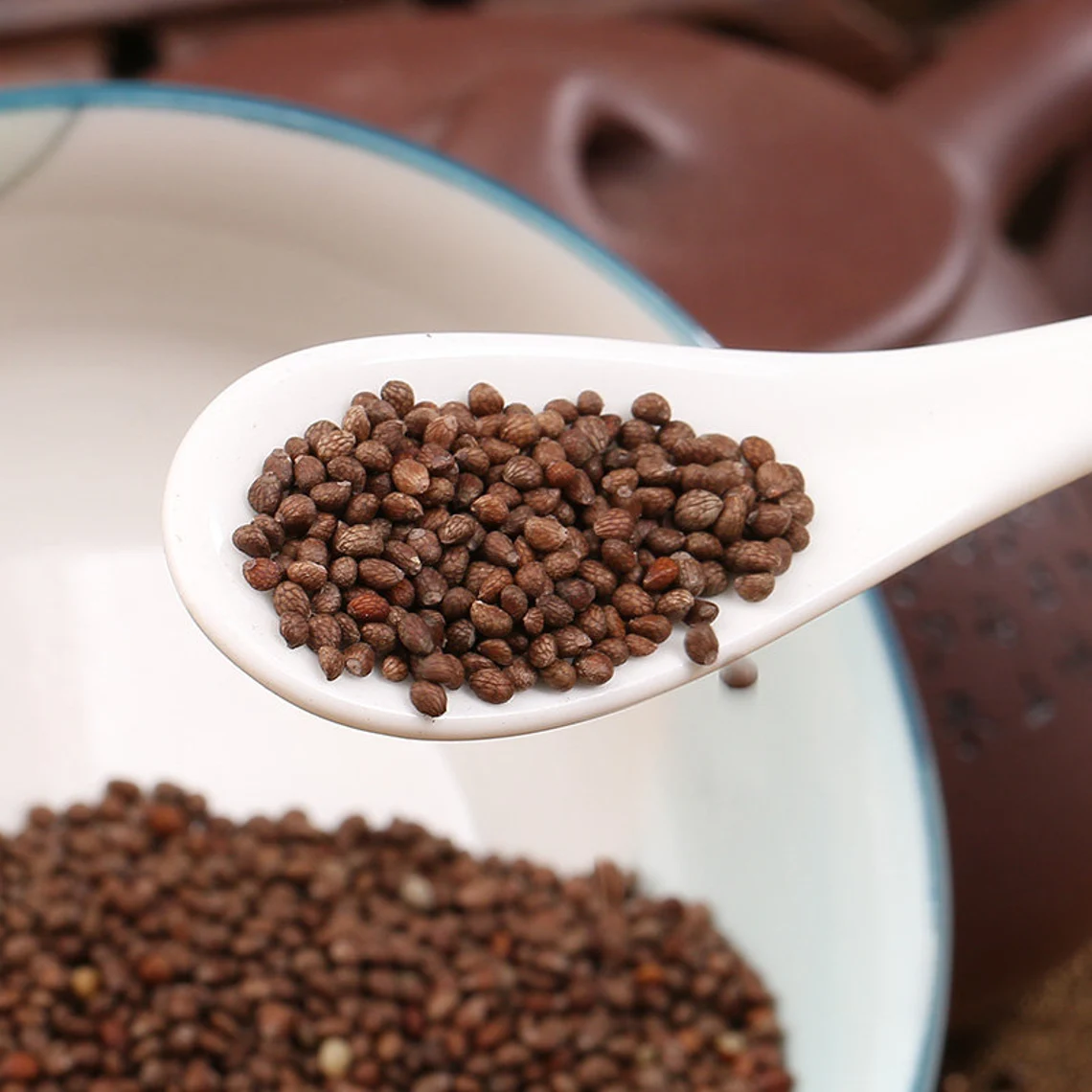If you’ve ever been to a good Japanese or Korean shusi restaurant in the United States, you know that the raw fish is inevitably served with sliced ginger and whole green, or sometimes purple, leaves.2 These are shiso leaves. They have a strong and complex flavor, and together with ginger allow you to “cleanse your palette” between slices of fish. But, did you ever imagine that the ginger and the shiso provide more than just flavor, and are actually medicinal substances in the Chinese pharmacopia, with medical properties specifically related to protecting your body from fish and shellfish related food poisoning? In otherwords, their presence on the sushi plate is about more than just flavor.
Perilla, the English name for shiso, has several fascinating and even unique functions in Chinese Medicine (CM). This article is part of an occasional series exploring plants we encounter in our daily lives which are also important medicinal substances in CM, and which can illustrate some of the more interesting aspects of this medical system.
Seafood Toxicity
Perilla leaves have a unique function. It is the only herb in the Materia Medica that has the specific function to relieve seafood toxicity. There are quite a few herbs which address food poisoning, or toxins in general, but none other is specific to seafood. On the other hand, the most important herb to relieve toxicity in general is fresh ginger (shēng jiāng 生薑), which is commonly used to process toxic medicinal substances prior to administration. Clinically, the two are almost always used together to treat patients with fish or shellfish poisoning.
Using them together follows the herbologic principle that one plus one sometimes equals three. Certain herbal combinations are recognized as not only complementing each others functions, but potentiating them, making their effects stronger than they would be if used alone. Culinarily these two are also frequently used together, and good cooks recognize that this strange mathematics applies in their domain as well.
Perilla
Perilla is zǐ sū (紫蘇) in Chinese. Zĭ (紫) means purple, the original color of the plant, green varieties being more recently developed for culinary purposes. Sū (蘇) means “revive”. This has a specific medical meaning beyond the generic one, and often refers to restoring consciousness to a patient. It also refers to “waking up” the digestive system, as we’ll see.
The plant is generally warming and pungent, and affects the respiratory and digestive systems. In CM, this implicates the Lung and Spleen Systems4, with their paired organs, the Large Intestines and Stomach. These are the organs which are responsible for providing the body with qì (氣), blood (xuè 血), and the other physical resources required for daily living. Food is processed in the Spleen/Stomach with oxygen provided by the Lungs, which also spreads the qì (氣) throughout the body, waste materials being eliminated by the Large Intestine.
The earliest references to zĭ sū yè (紫蘇葉) date back to the 5th century C.E. The leaves have a strong and complex, minty, peppery flavor, mixed with hints of cinnamon. It is a member of the mint family. In addition to being pungent, the leaves are aromatic, with many volatile, essential oils. In the Materia Medica, they are grouped with the many herbs used to treat colds and flu in patients with chills and no sweating. Internally, it focuses on the abdomen and digestion. It is the other functions and indications which make the herb so interesting, though. In addition to relieving seafood toxicity, which we already discussesd, the leaves can calm the fetus. I look at this fascinating concept below.
Perilla stems are less commonly used clinically. They do share some of the properties and functions of the leaves, albeit with weaker effect. Unlike the leaves, they help to relieve lung congestion.
The seeds are focused on the lungs and large intestines. The close connection between these two organs is rather mysterious at first glance, but fundamental to physiology in CM, as I will explain later. The seeds, as is true with many seeds, are considered to have a downward movement. (Directionality is another of the many ways herbs are classified.) This downward movement means that it can drain the congestion from the lungs and/or alleviate constipation.
Calming fetuses
Among the many functions attributed to herbs in Chinese Medicine, one that seems somewhat peculiar is that of herbs that calm the fetus. Herbs with this function have two main uses: treating pregnancy-related concerns in the mother, and protecting the developing fetus from the negative impacts of herbs intended to treat the mother.
In the latter case, it is common practice among gynecologists, or any doctors treating pregnant women, to include a small amount of such an herb to protect the fetus from any side effects of formulas administered for the benefit of the mother. The idea of calming the fetus in this context is, in a sense, letting the fetus know that the other herbs are not intended for itself, and to just ignore them.
The former case, that of treating pregnancy-related conditions, is somewhat more interesting. From the perspective of the mother’s body, the fetus is a source of stagnation in the body, specifically stagnation of phlegm, qì (氣), and blood (xuè 血). In an uncomplicated pregnancy, especially if the woman has no pre-existing health conditions, a woman’s body is able to respond and “work through this”, keeping everything flowing as normally as possible. But pregnancy is hard on the body.
Morning sickness is a common example of the stagnation of phlegm caused by the fetus manifesting in the stomach, with symptoms of nausea, vomiting, and poor/unusual appetite. The qì (氣) of the stomach is unable to descend normally into the intestines. This results in a condition with the colorful name of rebellious qì, meaning nausea and vomiting in this context. It is this condition that zǐ sū yè (紫蘇葉) is particularly effective in treating, combined, of course, with other herbs, such as fresh ginger (shēng jiāng 生薑).
“Wake up, Spleen!”
Harnessing the sense of smell
Phlegm is one of the pathogens identified in Chinese medicine. It is probably the most difficult to understand for students and the most difficult to treat for the practitioners. Phlegm includes the stuff you cough out of your lungs, which is called visible phlegm, but also includes invisible phlegm, which can bring internal systems to a halt. Phlegm is closely related to another pathogen, dampness, but many doctors consider phlegm to be a component of all chronic disease. In extreme cases, when phlegm affects the Heart System it can lead to loss of consciousness. When if affects the Lung and Spleen, it can cause severe chest and abdominal congestion and pain, and disorders such as COPD7.
The Spleen and Stomach are the center of the body, sometimes referred to as the “pivot”, and are together responsible for the upward and downward motion of substances in the body. Downward movement ensures that food and drink move smoothly through the GI tract to the point of elimination, while upward movement sends the nourishment, qì (氣) and xué (學) to the Lungs and Heart respectively, whence they are distributed throughout the body. The Spleen is, in fact, the primary organ orchestrating all of this while also being responsible for processing phlegm in the body.
Phlegm, especially severe cases, is treated with aromatic substances. This is a special flavor and is not one of the standard five.8 Aromatic herbs act through the sense of smell, the sense associated with the Lungs, rather than the sense of taste, which is associated with the Spleen. These herbs typically contain large amounts of volatile, essential oils. Most people are familiar with using smelling salts to revive consciousness. Smelling salts are ammonium compounds. In CM, we use musk and several plant resins for the same purposes. In treating phlegm in the Lungs and Spleen, many other herbs are available, such as zǐ sū yè (紫蘇葉).
Lungs and Intestines
The end of the tale
The seeds of the perilla are used for two conditions, with a connection that illustrates a fascinating aspect of the traditional Chinese understanding of human physiology. Zǐ sū zĭ (紫蘇子) treats both lung congestion and constipation. This seems somewhat random or unconnected, but from a CM perspective, the conjunction of these two functions in a single substance is very natural.
First, regarding the Lungs, the seeds are used to treat such conditions as asthma, COPD, or certain types of flu. Chinese herbology is all about combinations. Herbs are not used singly, but together with others, often in specific pairs or triplets of herbs. To treat lung conditions, perilla seed is combined with radish seeds (lái fú zĭ 萊菔子) and mustard seeds (bái jiè zǐ 白芥子). It is noteable that many culinary spices are actually recognized in CM as medical substances used to treat digestive disorders.
Zǐ sū zĭ (紫蘇子) is also used to treat constipation. Its high oil content makes it useful to treat constipation with dry stool, a condition common in the elderly. It is usually combined with other high-fat seeds for this purpose, in particular cannabis seeds (huǒ má rén 火麻仁), the principle medicinal substance in the Materia Medica for this condition.
In Chinese Medicine, there is a concept of paired organs. In Chinese philosphy, all things ineveitably have yin aspects and yang aspects, and the organ system is no exception. The five organ systems in CM are actually composed of pairs of organs. Some are obvious, like the Liver (yin) being paired with the Gall Bladder (yang), or the Kidney (yin) paired with the Urinary Bladder (yang). Others are strange, such as the pairing of the Lung, a yin organ, with the Large Intestines, a yang organ.
Now that we understand that the Lungs play an important part in the digestive process, it makes some sense that the large intestine would be paired with the Lung, thereby incorporating elimiation in the overall process. But there is also a spiritual aspect to the Lung/Large Intestine relationship, one which recalls the calm the fetus function of the leaves. According to the Taoist philosophy underlying CM, when one is born, and takes the first breath, the mortal spirit (pò 魄) enters the body. When one dies, the spirit leaves the body through the large intestine. Sit with that one for a while ;-).
Conclusion
Perilla is a great example of medicine hiding in plain sight, as it were. It is also an example of the culinary history of a national cuisine being influenced by traditional medical practices.
References
Footnotes
Cheap restaurants will often put a little piece of jagged green plastic, resembling a leaf, kind of, to stand in for the shiso leaf.↩︎
Original photo from https://pxhere.com/en/photo/853091↩︎
The Spleen in Chinese medicine corresponds more closely to the Pancreas in terms of physiological function↩︎
Image from Sushi University↩︎
Image from Sushi University↩︎
Sweet, sour, salty, bitter and pungent↩︎



